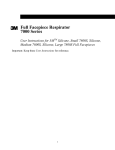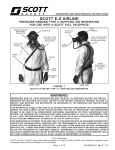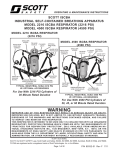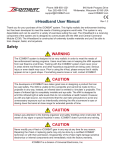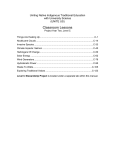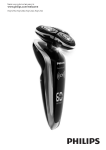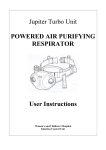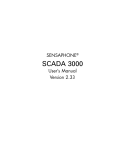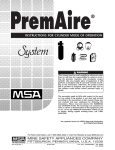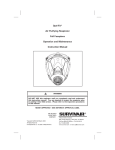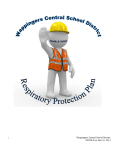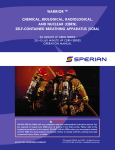Download respiratory protection policy - University of Alaska Fairbanks
Transcript
UNIVERSITY OF ALASKA FAIRBANKS SAFETY SYSTEM POLICY AND PROCEDURE DOCUMENT NUMBER: 502 ISSUE DATE: SEPTEMBER 1996 REVISION DATE: FEBRUARY 2012 SUBJECT: Respiratory Protection Policy RESPIRATORY PROTECTION POLICY PURPOSE: To provide guidelines for an effective respiratory protection program throughout the University of Alaska Fairbanks. OBJECTIVE: This document will apply to the administration and use of all respirators. SCOPE: To help ensure compliance with Alaska Department of Labor, Occupational Safety and Health Rules and Regulations, and other applicable rules and regulations governing minimum standards for an effective respiratory protection program. I. POLICY STATEMENT A respiratory protection program is hereby established to coordinate the use and maintenance of respiratory protective equipment as determined necessary to (1) reduce employee exposure to toxic chemical agents; (2) allow employees to work safely in potentially hazardous work environments; and (3) maintain compliance with state and federal safety laws. In attempting to minimize employee exposure to potentially hazardous chemical substances, the primary objective shall always be to achieve the needed control wherever feasible through engineering methods (such as exhaust ventilation) or administrative control. It is recognized, however, that for certain situations or operations, the use of engineering controls may not be feasible or practical. Under these circumstances or during an interim while engineering controls are being developed or installed, the use of personal protective respiratory equipment may be necessary. Therefore, a sound and effective program is essential to assure that the personnel using such equipment are adequately protected. 1 EHSRM Policy 502 II. PROGRAM ADMINISTRATOR The UAF Environmental Health, Safety, and Risk Management (EHSRM) department is the Program Administrator. The department is responsible for the management and administration of the Respiratory Protection Program, and charged with the following responsibilities: A. Supervision of respirator selection procedures. B. Establish and conduct training sessions for all respirator users. C. Establishment and management of a continuing program of cleaning, inspection, and maintenance of respiratory equipment. D. Designation of proper storage areas for respiratory equipment. E. Establishment of issuance and accounting procedures for users of respiratory equipment. F. Assurance that the necessary medical approval has been received for each user of respiratory equipment. G. Continuing inspection and evaluation of all aspects of the respiratory protection program to assure its continued operation and effectiveness. For additional help on any questions or problems concerning the proper selection and use of respirators, consult EHSRM at 474-5413. III. INTRODUCTION At certain times, or for certain operations, the use of respiratory protective equipment at UAF facilities may be required or advisable. Under these circumstances, it is essential that the correct type of equipment is used, that it is clean and in good working order, that a good fit is assured, and that the user is adequately trained in the use, care and limitations of the protective device. The "Respiratory Protection Policy" described below is designed to set forth accepted practices and legal requirements governing selection and use of respirators, as well as to provide information for training and guidance on fitting, care and maintenance of the respiratory protective equipment. IV. EMPLOYER AND EMPLOYEE RESPONSIBILITY A. Employer Responsibility 1. Respirators shall be provided by the employer when they are necessary to protect the health of the employee. 2. The employer shall provide a respirator which is applicable and suitable for the intended purpose. 2 EHSRM Policy 502 3. The employer shall be responsible for the establishment and maintenance of a respiratory protection program. B. Employee Responsibility 1. The employee shall use the respiratory protection in accordance with instructions and training received. 2. The employee shall be responsible for cleaning, inspecting, and making minor repairs on his/her respirator, if necessary, in accordance with instruction and training received. V. RESPIRATOR SELECTION A. No respirators shall be purchased or used unless their use and intended application has been approved by EHSRM. B. Only NIOSH/MSHA approved respirators shall be used. C. Respirators shall be selected on the basis of the potential hazard to which the worker is exposed. The following factors must be considered in making this selection. 1. The identity of the substance(s) and environment for which protection is needed. 2. The physical state of the contaminant (mist, mold, etc., or a combination thereof). 3. The permissible exposure limit or toxicity of the substance. 4. Exposure measurements showing the concentration likely to be encountered. 5. The protection factor listed for the respirator type. 6. The possibility of skin absorption or severe eye irritation. 7. The possibility of oxygen deficiency. 8. Any limitations or restrictions applicable to the types of respirators being considered which could make them unsafe in the environment involved. D. At no time shall a respirator be selected which offers less protection than required for the particular conditions under which it is to be used. However, if desired, a respirator type offering a greater protection factor than needed may be selected. E. Measurements to determine or predict the potential exposure concentrations shall be made by or in consultation with EHSRM. F. No respirator shall be used for any purpose unless the "Respirator Selection Check-list" for that application has been completed. 3 EHSRM Policy 502 VI. EXCLUSIVE EMPLOYEE USE Insofar as practicable, all individuals who are required to wear respiratory equipment shall be provided such equipment for their exclusive use. An exception to this policy may be permitted for equipment used for emergency or rescue purposes. VII. USER TRAINING Any worker required to wear a respirator at any time shall receive training in the proper use, care and limitations of respirators. Training will be given by the Respirator Program Administrator, under the auspices of EHSRM. The following items shall be covered in the training session(s). A. The nature of the respiratory hazard; i.e., what specific chemical substances are present; what areas, operations, or conditions may involve potentially hazardous exposure; and what effects may result if the respirators are not used or improperly used. B. An explanation of why engineering controls are not immediately possible and a discussion of what efforts are being made to eliminate the need for respirators. C. An explanation of why the equipment type selected is the proper one and what factors affect selection. D. A discussion and demonstration on how to use the respirator; i.e., how to put it on, tighten the straps, test for proper fit, etc. E. Instruction on the proper techniques and importance of cleaning, disinfection, inspection, maintenance, and storage of the respirator. F. A discussion of the capabilities and limitations of respirators; i.e., in what environments or under what circumstances (such as oxygen deficiency) the respirator does not offer adequate protection. Some limitations are generally listed on the container in which the respirator is shipped, or in the user's manual. VIII. FIT TESTING A. Any worker required to wear a respirator shall be assured of having a proper fit. This shall be achieved by (1) an initial quantitative fit test and (2) either a positive or negative pressure fit test each time the respirator is used. 1. Quantitative Fit Test a. UAF uses the Dyna Tech Nevada 3000 Quantitative Fit Test instrument. It is a stand alone instrument using non-traditional methods to directly measure leak rate in respirators. b. The FT 3000 does not require an invasive probe into the respirator. This means that the subject can be tested in the actual mask worn in the workplace. 4 EHSRM Policy 502 c. To perform the test, the wearer dons the respirator. When the mask is properly positioned on the wearer's face, he/she takes a deep breath and hold. The FT 3000 is activated. A pump within the FT 3000 pulls air out of the facepiece until a predetermined "challenge pressure" is reached. The pump speed is then controlled to maintain a constant challenge pressure inside the facepiece (about five seconds). The negative pressure that exits will cause air leakage in the mask. Since all the respirator inlets are sealed, all sources of leakage into the mask are through the face-to-facepiece seal. Mask leakage is determined as a direct function of pump speed. Leakage is directly related to the respirator fit. The lower the leakage, the better the fit. Leak rate is reported in cubic centimeters per minute. B. If a satisfactory fit is not achieved by the quantitative test procedure as described above, another size or model respirator should be selected and the test repeated. C. Either a positive or negative pressure test for tightness of fit must be applied each time a respirator is used. 1. Positive Pressure Test a. Close off the exhalation valve with the palm of the hand. b. Exhale gently into the facepiece. c. Check for air leakage. The face fit is considered satisfactory if slight positive pressure can be built up inside the facepiece without any evidence of outward leakage. d. If leakage is detected, reposition facepiece or readjust straps and repeat the test. 2. Negative Pressure Test a. Close off the inlet of the mask(s), cartridge(s), or filter(s) by covering with the palm of the hand(s). b. Inhale gently so that the facepiece collapses slightly. c. Hold breath for 10 seconds. If the facepiece remains collapsed and no inward leakage is detected, the face fit is considered satisfactory. D. Respirators shall not be worn when conditions prevent a good face seal, as evidenced by failure of any of the fit tests. Such conditions which prevent a good face to mask seal include a growth of beard, sideburns, temple pieces on glasses, or missing dentures. 5 EHSRM Policy 502 IX. INSPECTION AND REPAIR A. Inspection Schedules 1. All respirators shall be inspected routinely before and after each use, and during cleaning. 2. Equipment designated for emergency use shall be inspected after each use, during cleaning, and at least monthly. 3. Self-contained breathing apparatus shall be inspected monthly. B. Record Keeping A record shall be kept of inspection dates and findings for all respirators maintained for emergency use. C. Inspection Considerations Each respirator user shall be thoroughly trained in the proper inspection procedures to ensure that the equipment is in good condition. Inspection shall include the following: 1. Check of headstraps for breaks or tears, loss of elasticity, and missing or malfunctioning buckles. 2. Check of facepiece for dirt, cracks, tears, holes, distortion, or any other signs of deterioration. 3. Check of valves for dust, dirt, or detergent residue on the valves or valve seat; cracks, tears, or distortion in the valve material; or missing or defective valve covers. 4. Check of filter elements for correct filter(s), missing or worn gaskets, worn threads, cracks or dents in filter housing, service life indicator and end of service date. 5. Any other checks as appropriate. D. Repair Damaged respirators shall be brought to the immediate attention of the supervisor. Repair shall be done by trained personnel with parts designated for the respirator. If immediate repairs cannot be made and a respirator is needed, a temporary replacement with the same model and size shall be issued. 6 EHSRM Policy 502 X. CLEANING AND DISINFECTION Where respiratory equipment is used routinely, respirators shall be cleaned after each use. Cleaning procedures shall include the following: A. Remove any filters, cartridges, and disassemble the major respirator parts. B. Wash all respirator parts (except cartridges and elastic headbands) in a cleaner-disinfectant solution at about 120 degrees F. Use a hand brush to remove dirt. C. Rinse thoroughly in clean, warm water to remove all traces of detergent, cleaner, sanitizer, and disinfectant. D. Air dry in a clean area. E. Inspect all parts; replace with new parts if defective. F. Reassemble the respirator and insert new or unexpired filters or cartridges. Make sure the seal is tight. G. Place the respirator in a new plastic bag and seal it for storage. H. Disposable type respirators shall be used for one shift only, and; therefore, need no cleaning or disinfecting. Disposal or requesting a new respirator is the responsibility of the user. Dust masks are not respirators. XI. STORAGE A. Respiratory equipment shall be stored so as to protect it from dust, sunlight, heat, extreme cold, excessive moisture, and damaging chemicals. B. Respirators shall be stored in a convenient, clean and sanitary location where they are protected against damage or distortion by overcrowding or by contact with tools, such as in a tool box. C. Routinely used respirators may be placed in clean plastic bags. D. Respirators shall be stored separately from the cartridges and in a single layer with the facepiece and exhalation valve in a near normal position to prevent the rubber or plastic parts from taking a permanent distorted set. E. Respirators kept ready for rescue purposes or emergency use shall be stored in a cabinet or case located in a non-contaminated but readily accessible area. 7 EHSRM Policy 502 XII. WORK AREA SURVEILLANCE Periodic air sampling shall be done to determine the continued necessity of respiratory protection and to assure that the proper respirators are being used if necessary. Employees may be required to wear personal air sampling equipment for this purpose. The information obtained shall be used to fill out or up-date the Respirator Selection Check-list. XIII. MEDICAL APPROVAL No person shall be assigned to a task requiring the use of respirators unless it has been determined that they are physically able to perform the work and use the equipment. The UAF physician shall determine what health and physical conditions are pertinent. The respirator users' medical status should be reviewed periodically. Please contact UAF EHS&RM (474-5413) for additional information on required medical approval. XIV. RESPIRATOR PROGRAM EVALUATION A. Periodic evaluation (at least annually) shall be made by the UAF EHS&RM to assure the continued effectiveness of the respiratory protection program. Such evaluation shall determine whether or not all requirements of the program as outlined above are being followed. B. Periodic feedback shall be solicited from the respirator users on the following points: 1. comfort 2. any change in facial area; such as, facial hair, glasses, dentures, etc. 3. ability to wear...without objectionable effort 4. adequate visibility under all conditions 5. ability to perform all tasks without undue interference 6. confidence in the facepiece fit C. Frequent random inspections shall be conducted by the UAF EHS&RM Department to assure that the proper respirators have been selected, that employees are in fact wearing respiratory protection when and where necessary, that they are getting a good fit, and that the equipment is being properly cleaned, stored and maintained. D. Inspection dates and general conditions observed should be recorded and kept on file. 8 EHSRM Policy 502 XV. DISPOSABLE RESPIRATORS The use of disposable respirators still requires adherence to all applicable sections of this Respiratory Protection Program, including fit testing. Only Section IX, parts C and D, and Section X are excluded as they are obviously unnecessary. XVI. EMERGENCY EQUIPMENT A. Possible emergency use of respiratory protective equipment should be anticipated and planned. B. Written procedures shall be prepared covering the safe use of the equipment in dangerous atmospheres that might be encountered in an emergency. C. Periodic training sessions shall be held for those individuals most likely to use the equipment in an emergency. Training shall include demonstration and practice in putting on the respirator, testing for fit, discussion of the capabilities and limitations of the equipment, etc. The equipment manufacturer's instructions should be closely followed. D. If atmosphere involved is immediately dangerous to life or health, standby persons must be present with suitable rescue equipment. EHSRM must be immediately notified if the area is dangerous, and entry may be denied. 9 EHSRM Policy 502 APPENDIX A UAF RESPIRATORY PROTECTION PROGRAM RESPIRATOR SELECTION CHECK-LIST 1) Area or operation ________________________ 2) Chemical substance(s) involved ________________________ 3) Physical state of contaminant ________________________ 4) Permissible exposure limit ________________________ 5) Concentration range measured/anticipated_______________________________ 6) Date of last measurement(s) ________________________ 7) Any changes in the operations which might significantly increase anticipated contaminant level: Yes No (circle one) 8) Is environment immediately dangerous to life or health? ____ 9) Can contaminant be absorbed through skin? ____ Eye irritant? ____ 10) Any chance for oxygen deficiency? ____ Measurement needed? ____ 11) Is NIOSH approved respirator available? ________________________ On the basis of the above information, the following respirator(s) have been selected and approved for the area or operation listed above. Manufacturer Model/No. (including cartridge) NIOSH TC Approval No. _____________ _______________________________________________________________ _____________ _______________________________________________________________ _____________ _______________________________________________________________ No other respirators may be used without the express approval of the undersigned. Signed: _______ Date___________________ Respiratory Program Administrator Environmental Health, Safety, and Risk Management 10 EHSRM Policy 502 APPENDIX A1 UAF RESPIRATORY PROTECTION PROGRAM RESPIRATOR SELECTION CHECK-LIST 1. Area or Operation_______________________________________________________ 2. Chemical substance(s) involved__________________________________________ 3. Physical state of contaminant____________________________________________ 4. Permissible exposure limit________________________________________________ 5. Concentration range measured/anticipated________________________________ ________________________________________________________________________ 6. Date of last measurement (s)_____________________________________________ 7. Any changes in the operations which might significantly increase anticipated containment level: YES________ NO_______ 8. Is environment immediately dangerous to life or health?____________________ 9. Can containment be absorbed through skin?___________ Eye Irritant?_______ 10. Any chance for oxygen deficiency?_______ Measurement needed?_________ 11. Is NIOSH approved respirator available?___________________________________ On the basis of the above information, the following respirator(s) have been selected and approved for the area or operation listed above. Manufacturer Model No. (Including cartridge NIOSH TC Approval No.) _____________ _______________________________________________________________ _____________ _______________________________________________________________ _____________ _______________________________________________________________ No other respirators may be used without the express approval of the undersigned. Signed:___________________________________ Respiratory Program Administrator Environmental Health, Safety, and Risk Management Date:____________________________________ 11 EHSRM Policy 502











